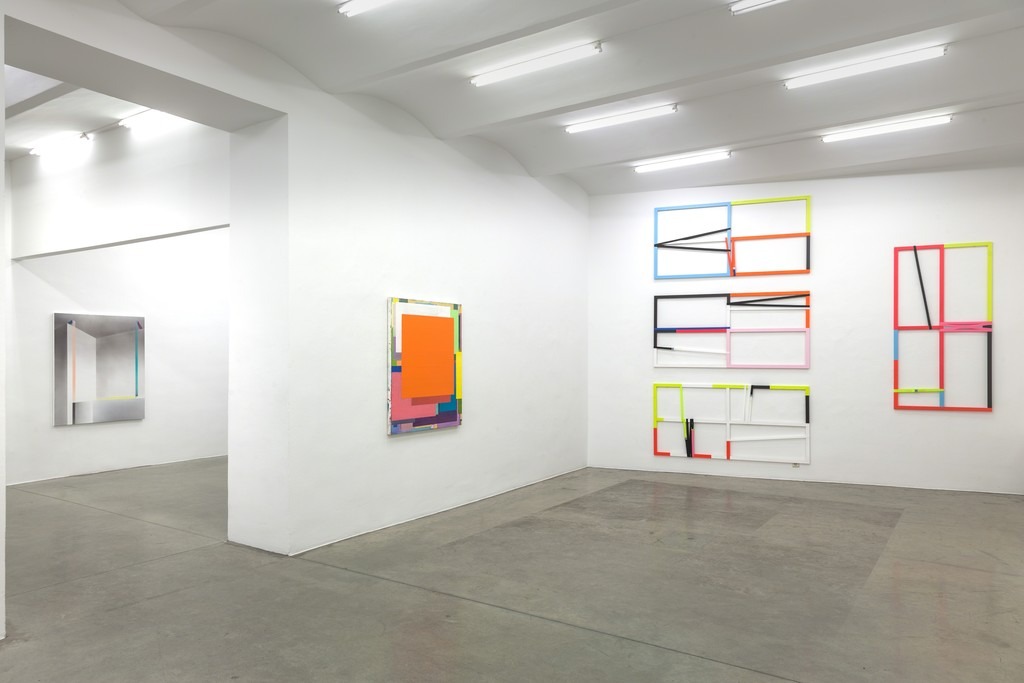Benjamin Appel, Fulterer Scherrer, Ira Svobodovà
Äpfel birnen ananas
24 Jan - 02 Mar 2019

BENJAMIN APPEL, FULTERER SCHERRER, IRA SVOBODOVÀ,
Äpfel Birnen Ananas, installation view
Christine König Galerie, Wien 2019
© Foto: Philipp Friedrich
Äpfel Birnen Ananas, installation view
Christine König Galerie, Wien 2019
© Foto: Philipp Friedrich
BENJAMIN APPEL, FULTERER SCHERRER, IRA SVOBODOVÀ
Äpfel birnen ananas
24 January – 02 March 2019
One should not compare apples to pears, and certainly not pears to pineapples. This explains the title of the exhibition, in which three artistic positions are united which at first sight appear similar yet which, upon closer inspection, demonstrate very idiosyncratic personalities – one could also say: their particular uniqueness. Taken together, the works of Benjamin Appel, Fulterer Scherrer and Ira Svobodovà create an aesthetic field of investigation between constructivist line organisation and freely interpreted colour field painting. All of the artists, however, are concerned with the transformation of painting, with going beyond the boundaries of what is associated with this genre in a traditional sense, and with the breaking out into a new artistic paradigm between and beyond.
Fulterer Scherrer work with brightly painted wooden wedge frames which here do not function as supporters of images, but instead are hypostasised as artistic design elements. The canvases are lost; what remains are the skeletons of the frames which, in interaction with used industrial straps, enact an anacreontic interplay of the rhythms and weights of the colours. "In their three-dimensionality and their permeability, the wooden constructions acquire connections to the space," the artists have written in an Artist Statement; "the panel painting can transform itself into an object."
Benjamin Appel cultivates a form of colour field painting which, like a palimpsest, layers geometric figures – generally rectangles or squares, gleaming in a monochrome blaze of colour – on top of one another in a sort of aesthetic of stratification, so that the effect of spatial depth is created. This is not completely dissimilar to the wall paintings of Ernst Caramelle, which can currently be viewed at his large-scale retrospective in MUMOK.
The Czech artist Ira Svobodovà evokes the three-dimensional space via works which accentuate the visual vernacularity of architecture and design. Svobodovà has developed an artistic language in which the proportions of construction and tension, of depth and space, are articulated. Coloured lines, which sometimes are reminiscent of the emblematic blue of Edward Krasiński, are organised into simple geometric bodies that have the effect of holographic projections in industrial spaces with streaked, dirty walls and floors.
The visitor should therefore enjoy the apples, pears and pineapples of this exhibition, which can absolutely be combined into a fruit basket. Yet for all the similarities between their attitudes and approaches to composition, it must remain clear: here three very different positions engender a charged relationship that seems to render the question of visual dominance obsolete, and that displaces the artistic negotiation virtually onto the meta level.
(Thomas Miessgang, 2019)
Äpfel birnen ananas
24 January – 02 March 2019
One should not compare apples to pears, and certainly not pears to pineapples. This explains the title of the exhibition, in which three artistic positions are united which at first sight appear similar yet which, upon closer inspection, demonstrate very idiosyncratic personalities – one could also say: their particular uniqueness. Taken together, the works of Benjamin Appel, Fulterer Scherrer and Ira Svobodovà create an aesthetic field of investigation between constructivist line organisation and freely interpreted colour field painting. All of the artists, however, are concerned with the transformation of painting, with going beyond the boundaries of what is associated with this genre in a traditional sense, and with the breaking out into a new artistic paradigm between and beyond.
Fulterer Scherrer work with brightly painted wooden wedge frames which here do not function as supporters of images, but instead are hypostasised as artistic design elements. The canvases are lost; what remains are the skeletons of the frames which, in interaction with used industrial straps, enact an anacreontic interplay of the rhythms and weights of the colours. "In their three-dimensionality and their permeability, the wooden constructions acquire connections to the space," the artists have written in an Artist Statement; "the panel painting can transform itself into an object."
Benjamin Appel cultivates a form of colour field painting which, like a palimpsest, layers geometric figures – generally rectangles or squares, gleaming in a monochrome blaze of colour – on top of one another in a sort of aesthetic of stratification, so that the effect of spatial depth is created. This is not completely dissimilar to the wall paintings of Ernst Caramelle, which can currently be viewed at his large-scale retrospective in MUMOK.
The Czech artist Ira Svobodovà evokes the three-dimensional space via works which accentuate the visual vernacularity of architecture and design. Svobodovà has developed an artistic language in which the proportions of construction and tension, of depth and space, are articulated. Coloured lines, which sometimes are reminiscent of the emblematic blue of Edward Krasiński, are organised into simple geometric bodies that have the effect of holographic projections in industrial spaces with streaked, dirty walls and floors.
The visitor should therefore enjoy the apples, pears and pineapples of this exhibition, which can absolutely be combined into a fruit basket. Yet for all the similarities between their attitudes and approaches to composition, it must remain clear: here three very different positions engender a charged relationship that seems to render the question of visual dominance obsolete, and that displaces the artistic negotiation virtually onto the meta level.
(Thomas Miessgang, 2019)
